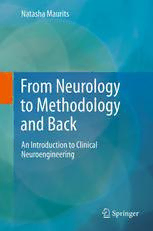
From Neurology to Methodology and Back: An Introduction to Clinical Neuroengineering PDF
Preview From Neurology to Methodology and Back: An Introduction to Clinical Neuroengineering
From Neurology to Methodology and Back Natasha Maurits From Neurology to Methodology and Back An Introduction to Clinical Neuroengineering NatashaMaurits DepartmentofNeurology UniversityMedicalCenterGroningen Groningen,TheNetherlands [email protected] ISBN978-1-4614-1131-4 e-ISBN978-1-4614-1132-1 DOI10.1007/978-1-4614-1132-1 SpringerNewYorkDordrechtHeidelbergLondon LibraryofCongressControlNumber:2011936974 #SpringerScience+BusinessMedia,LLC2012 Allrightsreserved.Thisworkmaynotbetranslatedorcopiedinwholeorinpartwithoutthewritten permissionof the publisher (SpringerScience+Business Media, LLC, 233 SpringStreet, New York, NY10013,USA),exceptforbriefexcerptsinconnectionwithreviewsorscholarlyanalysis.Usein connectionwithanyformofinformationstorageandretrieval,electronicadaptation,computersoftware, orbysimilarordissimilarmethodologynowknownorhereafterdevelopedisforbidden. Theuseinthispublicationoftradenames,trademarks,servicemarks,andsimilarterms,evenifthey arenotidentifiedassuch,isnottobetakenasanexpressionofopinionastowhetherornottheyare subjecttoproprietaryrights. Printedonacid-freepaper SpringerispartofSpringerScience+BusinessMedia(www.springer.com) Preface There are many textbooks that teach the basics and more advanced concepts of mathematical techniques and engineering approaches or the pathophysiology of neurological disorders. But for some readers, such a specialized treatise is more than bargained for. A medical doctor, who wants to interpret an EEG spectrum, does not need to know all intricacies of Fourier theory. On the other hand,anengineerwhowantstoemployspectralanalysistechniquestoimprovethe differential diagnosis of tremor, does not need a full understanding of tremor pathophysiology. Yet, both for physicians and engineers, it is important to bridge thegapbetweentechnologyandmedicine. With this book, I hope to provide a guide for those interested in crossing over from the field of medicine – neurology in particular – to the field of technology andviceversa.Neurologistsandresidentsinneurology,medicalengineers,medical students, biomedical engineers and students, technical medicine students, or studentsofotherinterdisciplinaryfieldsmaythereforeallfindthisbookinteresting anduseful. This text is inspired by a lecture series that I started teaching to residents in neurologybackin2006.Thegoalofthatlectureserieswastoexplainmathematical and physical principles underlying neurological diagnostic techniques to medical doctors.Beingamathematicianbytraining,Inoticedthatmyinitialmoreconven- tionalapproachwasnotoptimal;onlybyintroducingtheabstractconceptsthrough concrete neurological cases I was able to get my educational message across. Thisexperiencemotivatedmetochooseanuncommonapproachforthisbook. Eachchapterstartswithanoutlineofwhatshouldbeknownafterstudyingthe chapter.Then theneurological problems ofinterest areintroduced throughoneor more patient cases. Subsequently, the neurodiagnostic technique that can help establish a diagnosis is outlined and the necessary mathematics, physics, or engi- neering principles are explained. Finally, the new knowledge is applied to the patientcasesandotherapplicationsoftheneurodiagnostictechniquearediscussed. To help understand the essentials of each chapter, questions with answers are provided throughout the text. For the interested reader, mathematical details are v vi Preface provided in separate boxes, but they can be easily skipped by those with less background in mathematics. Furthermore, each chapter is completed with many illustrations, a list of easily accessible additional reading material and a glossary. This set-up is intended to make the book suited for self-study, but also for use in classroomlectures. This book would not have existed without Janne Geraedts and Aaldrik Sillius, whosupportedmeintransformingalong-existingideaintoabookproposalaspart of a faculty development programme I was participating in 2008. I am also very grateful to Michael Weston, senior editor at Springer, for receiving my book proposal with such great enthusiasm and for his and his assistant’s (Eric Farr) continuing support during the writing process. I highly appreciate the critical feedbackonthemanuscriptbymycolleagues(JanKuksandHanvanderHoeven) andPh.D.students(CarolienToxopeusandEstherSmits)attheUniversityMedical Center Groningen (UMCG) and thank my colleagues Han van der Hoeven, Jan WillemElting,FieteLange,andAngelavanLoonattheUMCGforprovidingme withinterestingpatientcases.MycolleagueFleurvanRootselaarattheAcademic Medical Center(AMC) in Amsterdam provided a patient case and many valuable comments on the manuscript. My Ph.D. student Marja Broersma provided some photographs and supporting staff members Lukas Dijck, Janneke Sikkema, and Janette Bijmolt helped in obtaining the patient data. I thank you all for being so helpful.Iwouldliketothankmyparentsfortheircontinuinginterestinandloving support for my education, academic training, and work. Last but not least: Johan, thankyouforbeingsopositivelycritical,understanding,andsupportive(technically aswellasbycatering)whenIwaswritingforhoursinarowinourstudy. Groningen,TheNetherlands NatashaMaurits Contents 1 Introduction.............................................................. 1 2 CarpalTunnelSyndrome,Electroneurography, Electromyography,andStatistics...................................... 3 2.1 PatientCases........................................................ 3 2.2 Electroneurography:AssessingNerveFunction.................... 4 2.2.1 NervePhysiologyandInvestigation........................ 4 2.2.2 DiagnosingCarpalTunnelSyndrome...................... 9 2.3 Electromyography:AssessingMuscleFunction.................... 11 2.4 DiagnosticMeasures:WhatIs(Ab)normal? ....................... 13 2.4.1 SamplingthePopulation.................................... 13 2.4.2 NormalDistributions........................................ 14 2.4.3 DescriptiveStatistics........................................ 15 2.4.4 Correlations................................................. 16 2.4.5 TipsandTricksWhenUsingDescriptiveStatistics........ 19 2.5 ElectroneurographyinIndividualPatients ......................... 24 2.6 OtherApplicationsofElectromyographyinNeurology ........... 28 2.7 AnswerstoQuestions............................................... 29 Glossary................................................................... 29 References................................................................. 30 3 Tremor,Polymyography,andSpectralAnalysis ..................... 33 3.1 PatientCases........................................................ 33 3.2 TremorRecording:PolymyographyandAccelerometry........... 34 3.3 SpectralAnalysis.................................................... 35 3.3.1 TremorFrequencyandPeriod.............................. 35 3.3.2 TowardSpectralAnalysisofTremorbyComputer: Sampling.................................................... 37 3.3.3 ObtainingFrequencyContentfromaDigitizedSignal: FourierTransform........................................... 41 vii viii Contents 3.3.4 TipsandTrickswhenInterpretingSpectra................. 45 3.4 TremorAnalysisinIndividualPatients............................. 52 3.5 OtherApplicationsofSpectralAnalysisinNeurology ............ 61 3.6 AnswerstoQuestions............................................... 64 Glossary................................................................... 65 References................................................................. 66 4 Epilepsia,Electroencephalography,Filtering, andFeatureExtraction ................................................. 67 4.1 PatientCases........................................................ 67 4.2 Electroencephalography:MeasuringtheBraininAction.......... 68 4.3 Filtering............................................................. 72 4.3.1 BiologicalArtifacts......................................... 74 4.3.2 TechnicalArtifacts.......................................... 76 4.3.3 FilteringintheFrequencyDomain......................... 78 4.3.4 TypesofFilters ............................................. 82 4.3.5 FilteringintheTimeDomain:Smoothing ................. 84 4.3.6 RelationshipBetweenFilteringintheFrequency andTimeDomain........................................... 85 4.3.7 DosandDon’tsofFiltering................................. 87 4.4 FeatureExtraction................................................... 87 4.4.1 TemplateMatchingandWaveletAnalysis................. 89 4.4.2 EEGSpikeDetection ....................................... 89 4.5 EEGFindingsinIndividualPatients ............................... 91 4.6 OtherApplicationsofEEGRecordingsinNeurology............. 93 4.6.1 MonitoringofCarotidArteryEndarterectomy.............. 94 4.6.2 MonitoringofStatusEpilepticusinIntensive CareUnits.................................................... 96 4.6.3 ConfirmationofBrainDeath ................................ 98 4.7 AnswerstoQuestions................................................ 99 Glossary................................................................... 100 References................................................................. 101 5 MultipleSclerosis,EvokedPotentials,andEnhancing Signal-to-NoiseRatio.................................................... 103 5.1 PatientCases........................................................ 103 5.2 EvokedPotentials:AssessingSensoryPathwayFunctioning...... 104 5.3 ObtainingEvokedPotentials........................................ 104 5.3.1 EnhancingSignal-to-NoiseRatio........................... 104 5.3.2 StimulationProtocols....................................... 105 5.3.3 AssessingReliability........................................ 107 5.3.4 QuantifyingandInterpretingEPs........................... 108 5.3.5 StepsinCalculationofEvokedPotentialAverages........ 111 Contents ix 5.4 TypesofClinicalEvokedPotentials................................ 112 5.4.1 VisualEvokedPotential .................................... 112 5.4.2 SomatosensoryEvokedPotential........................... 115 5.4.3 BrainstemAuditoryEvokedPotential(BAEP)............. 117 5.5 EvokedPotentialsinIndividualPatients........................... 119 5.6 OtherApplicationsofEvokedPotentialsinNeurology............ 121 5.6.1 IntraoperativeMonitoring:SEPinScoliosisSurgery...... 123 5.6.2 BAEPtoAssessHearingThreshold........................ 125 5.7 AnswerstoQuestions............................................... 125 Glossary................................................................... 126 References................................................................. 127 6 CorticalMyoclonus,EEG-EMG,Back-Averaging, andCoherenceAnalysis................................................. 129 6.1 PatientCases........................................................ 129 6.2 SimultaneousEEG-EMGRecording:Relating BrainandMuscleActivity.......................................... 130 6.3 Back-Averaging..................................................... 132 6.3.1 PrinciplesofandPrerequisitesforBack-Averaging ....... 132 6.3.2 Back-AverageCalculation.................................. 133 6.3.3 TipsandTricksWhenIdentifyingEMGOnsets........... 134 6.4 CoherenceAnalysis................................................. 137 6.4.1 Coherence:SignalCorrelation intheFrequencyDomain................................... 138 6.4.2 TipsandTricksWhenCalculatingCoherence............. 139 6.5 EEG-EMGAnalysisinIndividualPatients......................... 142 6.6 OtherApplicationsofCoherenceAnalysisinNeurology.......... 147 6.6.1 EEG-EEGCoherenceinAlzheimer’sDisease............. 149 6.6.2 EEG-EMGCoherenceAnalysis forTremorDiagnosis....................................... 150 6.6.3 BloodPressure-CerebralBloodFlowCoherence inCerebralAutoregulation.................................. 150 6.7 AnswerstoQuestions............................................... 152 Glossary................................................................... 152 References................................................................. 153 7 PsychogenicMovementDisorders,Bereitschaftspotential, andEvent-RelatedPotentials........................................... 155 7.1 PatientCase......................................................... 155 7.2 TheBereitschaftspotential:RecordingtheIntention toMovebySimultaneousEEG-EMG.............................. 156 7.3 CalculatingEvent-RelatedPotentials............................... 158 7.3.1 AreEvent-RelatedPotentialsDifferent fromEvokedPotentials?.................................... 158
